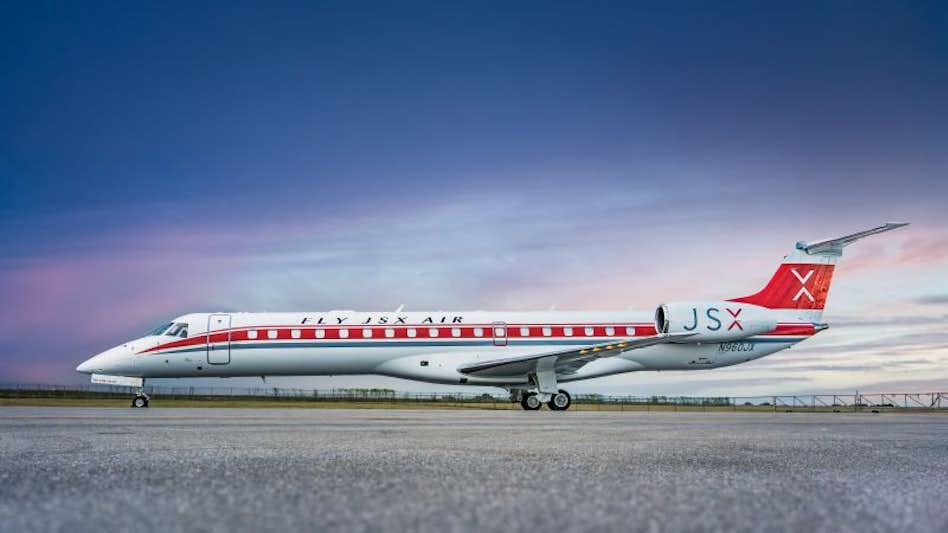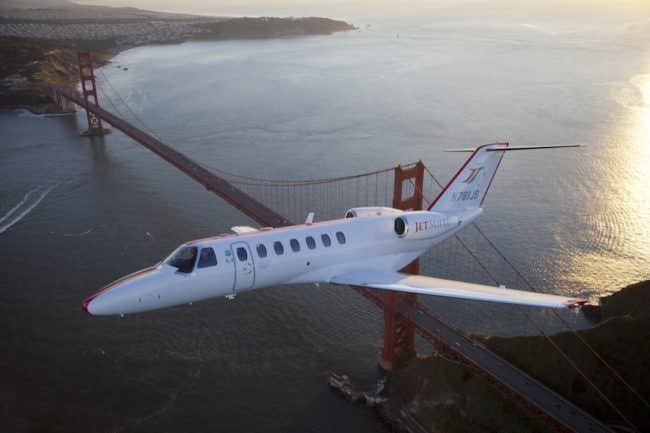
JetSuite is moving to an all Embraer fleet with the addition of Phenom 300s to its refurbished 100s.

JetSuite is a bit of a unique bird in the private aviation space. Its co-founder and CEO, Alex Wilcox, is not from business aviation but is a commercial aviation veteran. He was a co-founder of JetBlue (and JetBlue co-founder and aviation legend David Neeleman is a board member and investor in JetSuite). He also worked for Richard Branson at Virgin Atlantic Airways early in his career and later on was President of Kingfisher Airlines, an India-based airline started by the billionaire maker of beer by the same name.
Last year, JetSuite launched JetSuiteX running public charter scheduled flights (buy a seat) with reconfigured 30-seat Embraer 135s using private aviation facilities instead of main commercial terminals. On the short hops in the West, travelers often cut total travel time in half. It’s a different take on the Surf Air model.
You can see threads of Wilcox’s resume translate throughout JetSuite, including the distinctive red stripe branding on its aircraft (something folks in business aviation thought was a bit flashy when the operator launched in 2010), its use of social media (posting empty legs on Facebook) and its focus on providing a premium flight experience (free snacks and beverage and fleetwide free WiFi) at a non-premium price. However, won’t find any lifestyle perks and partnerships of other jet card membership programs. Wilcox believes there is a cost to offering those perks and that has to then be baked into the price.
JetSuite is an operator (as opposed to broker) program, and in fact, according to AIN’s 2017 Charter Report, JetSuite clocked the ninth most hours of any Part 135 operator on a fleet of just 20 aircraft so far this year. That reflects that its fleet of Embraer Phenom 100s and Citation CJ3s (which are being replaced by Phenom 300s) are well suited for short hops so get high utilization. In fact, at 48 minutes, SuiteKey has the lowest per segment minimum for the more than 100 programs Private Jet Card Comparisons has analyzed.
Typical Light Jet program minimum is at least one hour, and if you do a lot of short flights, that 12-minute difference can add up. For example, at the $100,000 SuiteKey membership, the average hourly rate for a CJ3 or P300 is $4,950. Over the course of 20 segments that are for instance 35 or 40 minutes each, the difference between the 48-minute minimum and one hour is $79,200 compared to $99,000.
Why do we say average hourly rate? That’s because rates vary based on city pair, with JetSuite keeping some five million pricing records. To figure out what the pricing is for the trips you will be flying is pretty easy but takes a bit of work. JetSuite offers instant retail charter quotes on its website. There are four SuiteKey programs, priced at $50,000, $100,000, $200,000 and $400,000. When you find the retail price for your preferred route hover over the Flight Time Rate line, which will tell you the hours you are using. Then deduct $400, $500, $600 or $700 per hour based on which level of SuiteKey you want to sign up for to figure out your hourly rate for that route.
The pricing variance takes into account the expense of ferry flights and so forth. What it means is the sweet spot for customers is those of you on the West Coast who want to fly north/south or to and from mountain resorts or up and down the East Coast since its fleet, even though it is a floating fleet, is mainly operating along the coasts.
As to other elements of the program, there are no peak days or peak day surcharges or minimum lead times for reservations, but there isn’t guaranteed availability which means the program is particularly good if you travel during holidays and so forth, but can make your reservations in advance. Non-program customers have various restrictions on advance reservations, protecting inventory for SuiteKey customers.
While JetSuite has just added an Embraer L650 under its new aircraft management program and is looking to add more, the principal fleet is the four-seat Phenom 100s and the P300s and CJ3s, seating up to seven, so again something to consider if you travel in larger groups or with extensive amounts of luggage.
There is no escrow program and your deposit is non-refundable. Wilcox points to JetBlue’s “significant” investment in JetSuite last year in terms of financial stability. “They’re a public company. Obviously, they did a heck of a lot of due diligence before investing,” Wilcox tells Private Jet Card Comparisons.
There are also varying roundtrip discounts, WiFi is available on all aircraft and Wilcox describes JetSuite as “pet-friendly.” The minimum age for unaccompanied age for minors is 12. One other element to consider is while it’s a short haul bird, the P100s only have a curtain-enclosed lav. On the positive side all P100 interiors were refurbished last year and for those of you who like consistency, you are buying into a standardized fleet. As the P300s come online, the CJ3s will phase out Wilcox says.